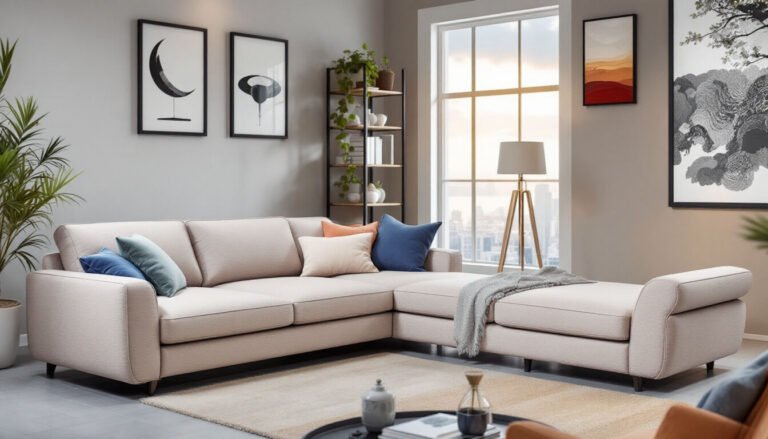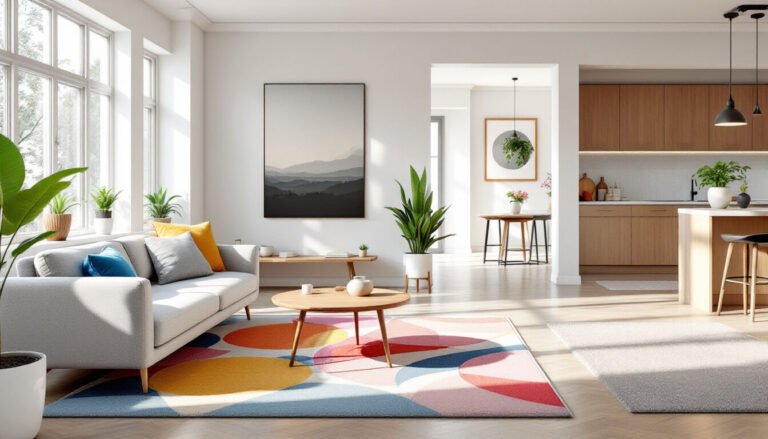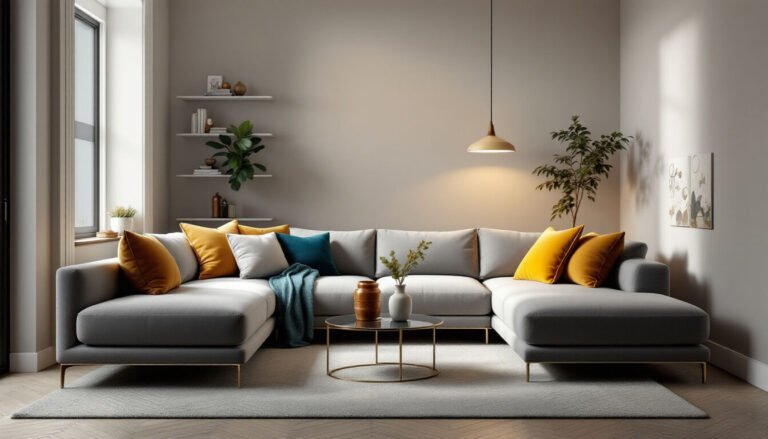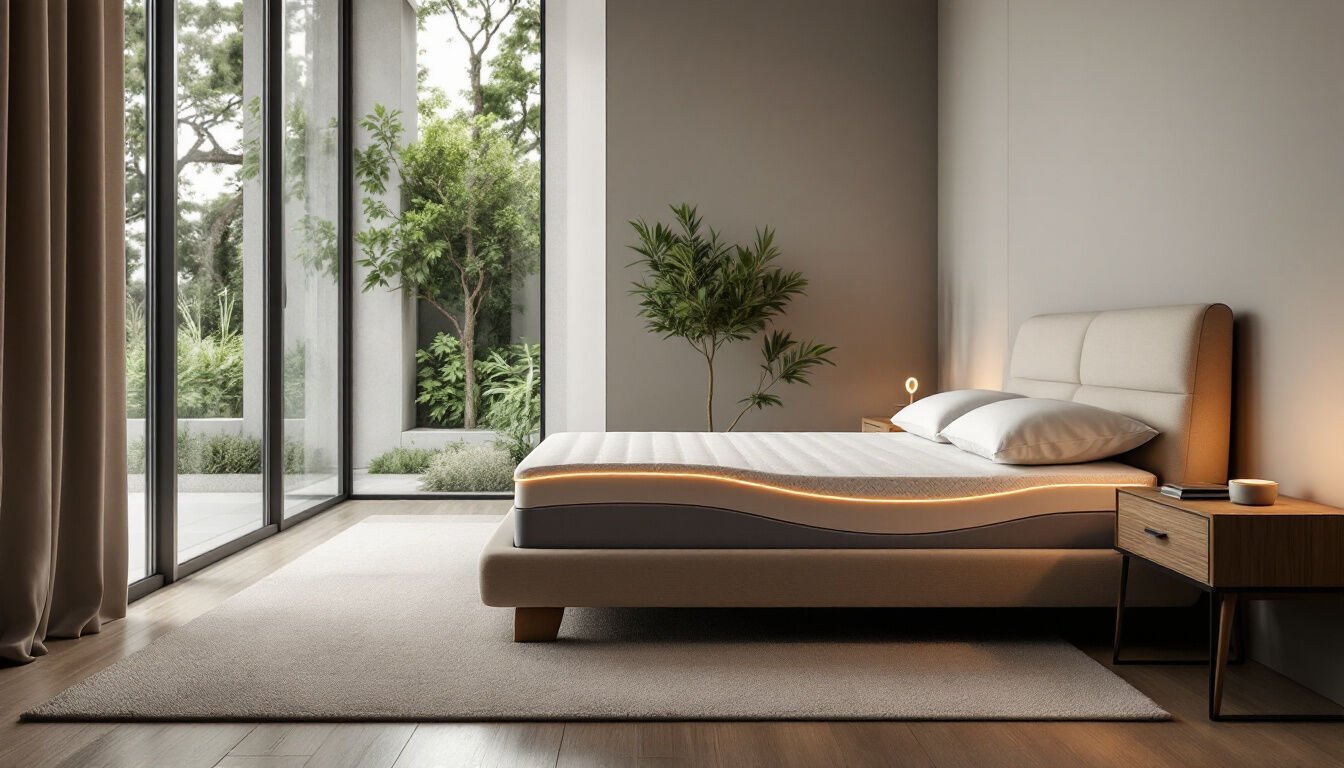Introduction
Boho home decor captures the essence of creative freedom, global influences, and laid-back charm. Its eclectic nature embraces colorful textiles, layered textures, and meaningful accessories. From vibrant colors to carefully curated vintage finds, the bohemian style exudes warmth and individuality.
In this guide, you’ll explore the roots of bohemian design, learn essential styling tips, and discover practical ways to infuse boho-chic into every room. Whether you’re an avid traveler craving a global fusion or someone seeking a cozy, personal retreat, boho decor invites you to break free from rigid rules. Ready to embark on a creative journey that transforms your living space into a comforting haven?
Keep reading to uncover the secrets of a truly free-spirited interior.
1. The Essence of Boho Home Decor
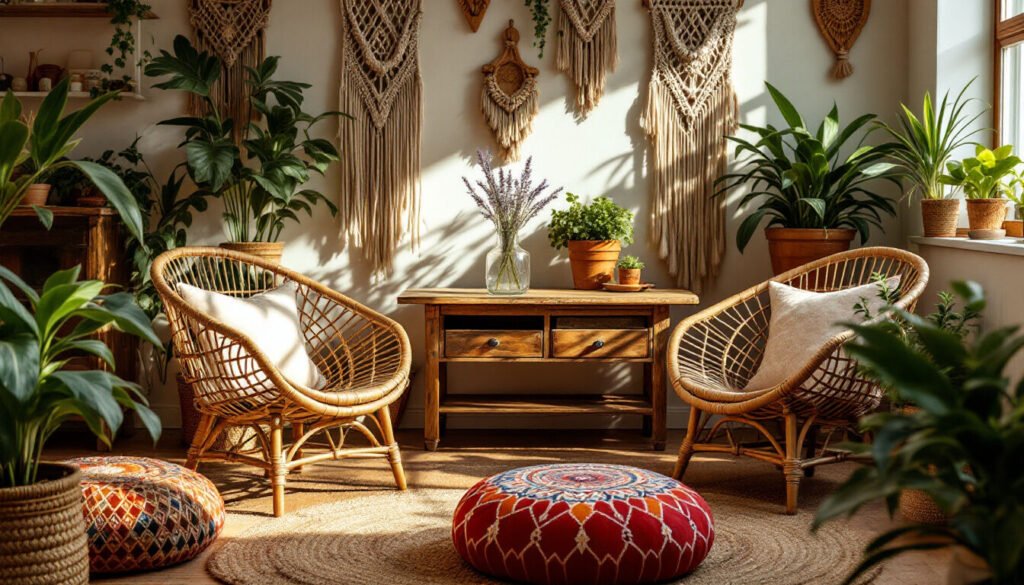
A. Historical Overview
The term “bohemian” dates back centuries, originally referring to nomadic travelers from the Bohemia region. Over time, the word also became synonymous with artistic circles that rejected societal norms. According to Beasley & Henley , modern boho design evolved from 1960s counterculture movements, celebrating handmade crafts and global inspiration.
This style is also shaped by North African, Middle Eastern, and Indian textiles. Each region contributes its own unique motifs and color stories. Today, boho décor stands as a creative fusion of these worldly elements, blending them into a harmonious, relaxed style.
Understanding its roots fosters a deeper appreciation for the rich tapestry of bohemian style.
B. Core Characteristics
Boho decor thrives on eclectic design and layered textures. According to RFP Design , popular hallmarks include vintage furniture, rattan chairs, woven baskets, and bright, vibrant colors. The mix-and-match approach is intentional, spotlighting personal stories and global influences.
Materials often lean toward natural or sustainable sources. Think wooden tables, jute rugs, or organic cotton throws. Bold textiles like Moroccan or tribal patterns add visual excitement. Decorative cushions, macramé wall hangings, and layered rugs give each space a comfy, free-spirited vibe.
By focusing on genuine materials and soulful accents, you can capture the boho essence effortlessly.
C. Why Boho Decor Is Trending
People crave a personalized, cozy ambiance at home, and boho design offers just that. Social media platforms like Instagram and Pinterest showcase inspiring boho rooms featuring lush greenery, artisanal crafts, and a tapestry of global prints. These spaces encourage relaxed living and self-expression.
Many also embrace boho decor because it celebrates sustainability through thrifted finds and handmade pieces. This approach meets the growing demand for eco-friendly interiors while maintaining style. It’s a trend that resonates with anyone seeking more color and warmth in their daily environment.
Next, let’s explore how to plan your boho-inspired retreat effectively.
2. Planning Your Boho Space
A. Setting a Vision Board
A boho design journey often begins with visual inspiration. Save images from Pinterest, follow design influencers on Instagram, or collect magazine clippings. This mood board serves as your creative roadmap, guiding decisions on colors, patterns, and furniture.
Before finalizing details, decide on the room’s function and choose focal points. In a living room, you might highlight a vintage sofa or a statement rug. In a bedroom, an ornate headboard could be the anchor. Aim for a cohesive mood, such as earthy and calm or vibrant and eclectic.
Clarity on your desired outcome helps you stay focused during shopping and DIY projects.
B. Budgeting and Shopping Strategy
Thrifting and flea market trips are a boho lover’s delight. You’ll find affordable pieces that carry unique character. As shared by HGTV , mixing high-end furniture with secondhand treasures is cost-effective and reduces waste.
Look for original or handcrafted items, especially those that celebrate cultural heritage. Online resale platforms also offer vintage gems. Reserve a portion of your budget for statement pieces, such as a plush Moroccan rug, and consider DIY for smaller decor.
Allocating funds wisely ensures your boho space remains stylish without breaking the bank.
C. Coordinating Colors and Patterns
Boho home decor often features a neutral base (whites, creams, beiges), layered with vibrant colors or global prints. Geometric motifs can coexist with floral or tribal designs, provided you maintain balance. Avoid overwhelming the room with too many clashing elements.
If you’re hesitant about mixing prints, start with one bold pattern, then add subtle supporting ones. Pillows, curtains, and rugs unify the look, offering interesting contrasts. Keep some negative space or muted tones to prevent visual overload.
In the next section, we’ll examine color palette essentials for a cohesive boho vibe.
3. Color Palette Essentials in Boho Home Decor

A. Earthy Neutrals as Base Tones
Earthy neutrals create a calming foundation for boho spaces. Soft browns, creams, and warm whites blend easily with natural elements like rattan or wood. Muted grays serve as a versatile alternative if you prefer a slightly cooler backdrop.
Painting walls in subdued tones allows your vibrant accessories to stand out. Neutral palettes also provide the flexibility to swap accent pieces seasonally or with changing tastes. This approach keeps your space timeless yet adaptable.
Building from these base hues helps each layer of boho detail shine.
B. Bold Hues and Accent Shades
Boho living embraces vibrant color. Jewel tones like emerald, ruby, or sapphire bring rich depth, while pops of mustard yellow or terracotta add energy. These colors often appear in tapestries, cushions, or even accent walls.
A balanced approach prevents overpowering the room. Limit bright shades to focal areas, such as a painted alcove or a statement rug. Let these lively touches complement your neutral backdrop for a visually cohesive arrangement.
Strategic accent hues turn any space into a kaleidoscope of bohemian joy.
C. Pastel Variations
Pastels offer a softer twist on boho style. Blush pinks, gentle greens, or pale blues infuse a whimsical, calming vibe. According to House Beautiful , pastel boho designs can still incorporate playful patterns and textures without feeling overly bold.
You might pair pastel curtains with a more vibrant Moroccan rug. Alternatively, pastel cushions can offset a darker couch. These combinations create a layered palette where each shade supports the other.
Pastels lend an airy, approachable dimension to the boho aesthetic.
D. Tips for Balancing Colors
Swatch testing is crucial. Paint small patches on your walls or gather fabric samples under different lighting conditions. Ensure your primary color scheme harmonizes with existing furniture.
Use the “60-30-10 rule” for color distribution. Let 60% be your base neutral, 30% a secondary hue, and 10% an accent color. This structure keeps the space coherent while allowing creative flourishes.
Next, we’ll delve into the fundamental materials that define boho home decor.
4. Key Elements and Materials
A. Textures and Fabrics
Boho design rejoices in layering. Pile up plush throws, embroidered pillows, and cozy rugs to establish a welcoming environment. Fabrics like velvet, cotton, or linen pair well with more rustic elements, such as woven baskets or jute mats.
Emphasize layered textures for visual intrigue and tactile comfort. Consider crocheted blankets on chairs or kilim rugs beneath coffee tables. According to Sonorous Love , choosing natural fibers helps maintain an eco-friendly ethos while adding boho charm.
Different weaves and materials create the soulful patchwork that defines boho decor.
B. Furniture Selection
Furniture often features vintage or handcrafted aesthetics. Rattan chairs, reclaimed wooden tables, and upcycled cabinets all fit seamlessly into a boho setting. Soft, low-profile sofas encourage relaxation, while floor cushions or bean bags reinforce a free-spirited atmosphere.
For a cohesive layout, mix older pieces with contemporary designs. If you have a modern coffee table, balance it with a boho macramé wall hanging. Functional furniture, like nesting tables or multi-purpose benches, helps adapt your home to different needs.
Strive for a comfortable blend of old and new, ensuring each piece tells a story.
C. Décor Accessories
Accessories provide the final flourish in any boho home decor scheme. Macramé wall hangings, crocheted plant holders, and woven baskets supply artistry and storage. Statement lighting, like pendant lamps or lanterns, can highlight corners or reading nooks.
When curating accessories, seek items that resonate with personal experiences or cultural influences. Showcase decorative bowls from your travels or a unique tapestry found at a local market. Boho style welcomes these intimate touches.
Decor flourishes connect your space to your passions and memories.
D. Plants and Greenery
Greenery breathes life into bohemian interiors. Hanging planters or tall potted palms echo nature’s soothing presence. Low-maintenance species like pothos or snake plants are perfect for those new to indoor gardening.
Combine different pot styles—clay, woven baskets, or painted terracotta—to maintain an eclectic vibe. If space is limited, hang small planters in a window or display them on macramé shelves. Keep your plants healthy with sufficient light and moderate watering.
Next, discover how to adapt boho decor to various rooms for a cohesive whole.
5. Creating a Cohesive Boho Home Decor Theme by Room

A. Living Room
The living room often serves as the central gathering spot. If you have a fireplace, it can be your focal point; otherwise, a plush sofa or feature wall might take center stage. Layer multiple rugs—like a jute base with a patterned kilim on top—for an eclectic boho ambiance.
Accessorize with textiles such as throw blankets or embroidered cushions. Open shelving can display global ornaments or mismatched pieces that share a cohesive color thread. For inspiration, Elle Decor features real-life boho living rooms that blend patterns seamlessly.
Allow your living room to reflect travels, hobbies, and personal taste.
B. Bedroom
A boho bedroom aims for tranquility while championing self-expression. Choose a statement bed frame, such as wrought iron or reclaimed wood, and layer it with crocheted throws and patterned pillows. According to Good Housekeeping , soft lighting and potted plants cultivate a serene vibe.
Incorporate vintage furniture, like a retro dresser, alongside modern touches (e.g., sleek lamps). Fairy lights or a wicker pendant can substitute harsh overhead fixtures. If space allows, add a corner reading nook with floor cushions.
Cozy layering and thoughtful styling create a restful boho bedroom that feels personal.
C. Dining Area
In the dining room, mix varied chair styles around a rustic wooden table. Mismatched upholstery or patterns can look cohesive if they share a color palette. Table runners and placemats featuring geometric or floral designs enhance the bohemian flair.
Emphasize handcrafted items, such as ceramic plates or handwoven placemats. Candleholders and small potted herbs add warmth. Keep the arrangement relaxed and inviting, perfect for casual dinners or entertaining guests.
Encourage conversation and connection through an eclectic yet charming dining setup.
D. Kitchen
Even kitchens can embrace boho style. Open shelving displays an array of eclectic dishes. Add a colorful backsplash with tiles reminiscent of Moroccan or Mediterranean patterns. Use decorative textiles—like embroidered tea towels—to tie everything together.
For practical storage, incorporate woven baskets for produce or spices. If space permits, hang a small macramé on the wall or place a succulent near the window. This approach merges boho chic with everyday functionality.
Let your kitchen celebrate global influences while remaining an efficient cooking space.
E. Bathroom
Transforming a bathroom into a boho oasis is simpler than you think. Opt for bamboo or wooden accents, such as a bench or shelving. Macramé curtains or shelving can replace traditional glass or plastic solutions.
Incorporate aromatherapy elements like essential oils or scented candles. Stone or terracotta planters with small ferns bring nature inside. The result is a spa-like retreat that still echoes the free-spirited boho vibe.
With the right details, even a bathroom can feel soulful and warm.
F. Outdoor Spaces (Balcony, Patio, Garden)
If you have outdoor areas, bring the boho theme beyond your walls. Weather-resistant rattan furniture or wicker chairs maintain comfort in a patio. Layer outdoor rugs and bright cushions, blending nature and style.
Potted flowers, climbing plants, or herb gardens introduce lively hues. Create a cozy reading corner with floor cushions and a small side table for drinks. Twinkling string lights or lanterns set a dreamy evening atmosphere.
Next, let’s review styling tips for mastering the boho look like a pro.
6. Styling Tips and Expert Insights
A. Layering Patterns and Textiles Seamlessly
Combining different prints or textures is key to boho. Large-scale florals can pair with geometric or tribal motifs. The trick is to keep a unifying hue or repeating element so the outcome doesn’t feel chaotic.
For instance, a neutral base rug might host smaller, patterned rugs in complementary shades. Continue layering with embroidered pillows, crocheted throws, or tapestry ottomans. Always maintain a sense of flow by reusing some shades throughout.
Layering adds depth, but mindful repetition ensures your space remains pleasing to the eye.
B. Mixing Old and New Elements
Boho decor thrives on bridging eras and styles. A modern sofa can coexist with a vintage trunk used as a coffee table. Repaint older furniture in subtle distress patterns or bright boho colors to refresh them.
Upcycling extends the life of pre-loved items, aligning with boho’s carefree, eco-friendly ethos. If you have treasured family heirlooms, incorporate them as focal pieces. Mixing new buys with old favorites makes your interior truly unique.
Upcycling merges sustainability with creativity, forging a space that feels truly personal.
C. Showcasing Global Influences
African mud cloth pillows, Moroccan lanterns, or Indian block-printed textiles infuse global flair. Display these pieces in harmony, letting each hold a distinct place. If you have souvenirs from travels, highlight them on shelves or walls.
Keep the overall palette cohesive despite the varied origins. For example, if you’re focusing on earthy tones, choose pieces that incorporate browns, greens, or terracotta. This synergy weaves multiple cultures into one boho tapestry.
Global inspirations let your home tell stories from around the world.
D. Use of Art and Wall Decor
Large framed paintings or a gallery wall can anchor a boho room. Gallery walls may include woven plates, masks, or photos in mismatched frames. Statement pieces, like a big mandala tapestry, can also serve as a conversation starter.
If you lean toward minimalism, choose one standout artwork to set the tone. For a more maximalist approach, layer smaller items in an organic arrangement. Either method enriches your living space with cultural depth.
Wall decor fosters self-expression and personalizes each corner of your home.
E. Curating Personal Items and Collections
Boho emphasizes personality over perfection. Don’t hesitate to show off that eclectic seashell collection or those quirky antiques. Arranging them in curated clusters around the house preserves the calm while celebrating your passions.
If you worry about overcrowding, rotate items every few months. This practice refreshes the look and keeps your boho sanctuary visually engaging. It also prevents dust from accumulating on lesser-used displays.
Now, let’s examine how boho design aligns with environmental consciousness.
7. Sustainability and Ethical Choices

A. Importance of Eco-Friendly Boho Decor
Many boho enthusiasts champion sustainability through repurposed or handmade pieces. Choosing items from local artisans and upcycling vintage furniture minimize your carbon footprint. Reclaimed wood or natural fibers reduce reliance on synthetic materials.
This mindful approach resonates with a broader shift toward conscientious consumerism. It encourages supporting local communities while building a beautiful home. The bohemian ethos, at its core, cherishes respect for the planet and its resources.
Eco-friendly design ensures your boho sanctuary fosters both relaxation and responsibility.
B. Supporting Local Artisans
Handmade rugs, hand-painted ceramics, and macramé creations from local makers add authenticity. Look for fair-trade labels when sourcing global crafts. This approach benefits artisans financially while preserving cultural traditions.
Check out local bazaars or craft fairs to unearth unique decor. You can find everything from clay pots to embroidered table runners. Each handcrafted piece embodies artistic passion, enhancing your boho interior.
Every artisan purchase weaves a narrative of heritage, craft, and ethical living.
C. Lasting Quality and Natural Materials
Investing in solid wood furniture or durable weavings ensures longevity. Natural fibers like cotton, wool, or hemp remain comfortable through the seasons. High-quality items typically require less frequent replacement, reducing waste.
If possible, choose biodegradable or recyclable materials over plastic-based decor. Look for labels indicating organic or sustainably sourced resources. Your boho design can thus stand the test of time without sacrificing style.
Longevity and mindful material selection uphold boho’s authentic and environmentally friendly spirit.
8. Common Mistakes to Avoid
A. Overusing Clashing Colors and Prints
While boho loves vibrancy, too many competing patterns cause chaos. Avoid filling every corner with loud prints. Instead, pick a key motif or color scheme and introduce complementary designs to maintain harmony.
If you notice an overwhelming effect, remove or rehome some items. Editing your collection helps each piece shine without drowning out others. This approach ensures the relaxed side of boho remains intact.
Balance boldness with restraint, so your interior feels dynamic but welcoming.
B. Forgetting Functional Space Planning
No matter how gorgeous your decor, a poorly arranged space disrupts daily life. Keep walkways clear, maintain practical storage solutions, and ensure you can navigate easily.
Work with the room’s shape and lighting to optimize flow. Boho doesn’t imply clutter; curated items still need designated spots. Embrace creativity, but let usability guide final placements.
Efficient space planning preserves comfort and fosters effortless living.
C. Failing to Incorporate Layers and Textures Properly
A boho interior can look flat if you limit yourself to a single texture. Cotton pillows, velvet throws, and woven baskets each serve different tactile purposes. Overlooking layering might leave the space lacking depth.
Aim to include at least three textural elements in any given area. Think a plush rug underfoot, a coarse woven runner on a table, and soft fringed curtains. These details amplify boho’s characteristic richness.
Layered textures keep boho spaces visually and physically comforting.
D. Purchasing Items Without a Cohesive Vision
With so many tempting prints and vintage finds, impulsive buying is easy. But each new piece should still align with your overall concept. If a purchase doesn’t complement your chosen palette or theme, consider passing on it.
Keep a mental or physical checklist of your color scheme and design goals. Then, you’re more likely to pick items that integrate seamlessly. This discipline saves money and maintains unity in your boho environment.
Next, let’s consider some fun DIY boho projects to spark your creativity.
9. DIY Boho Decor Projects
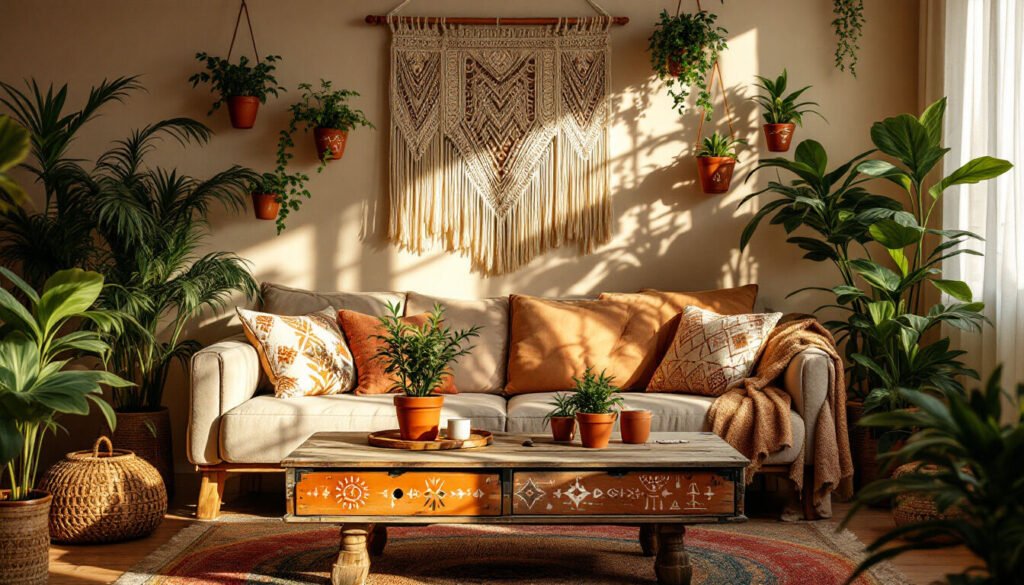
A. Simple Macramé Wall Hanging
Macramé stands among the most iconic boho accessories. You can create your own wall hanging using basic knots and cotton cords. Tutorials on HGTV offer step-by-step guidance, making this a beginner-friendly venture.
Hang your finished piece above a bed or sofa. Experiment with different yarn colors or incorporate beads for extra flair. It’s a low-cost way to decorate empty walls with personal artistry.
Macramé infuses the space with a breezy, handcrafted charm that defines boho design.
B. Painted Terracotta Pots for Indoor Plants
Adding color to plain terracotta pots heightens boho’s playful spirit. Use acrylic paints or chalk paint for a rustic finish. Geometric patterns or freehand designs look lively, especially when holding leafy greenery.
Seal your pots with a clear coat to protect them from water damage. Arrange these colorful planters on window sills or shelves for maximum impact. They offer a pop of color amid neutral backdrops.
Personalized planters reflect your creativity and complement the natural vibe of boho style.
C. Upcycled Furniture with Distressed Finishes
Give old wooden tables or cabinets a second life. Distress the finish by lightly sanding edges or applying a whitewash technique. Adding stencils of tribal patterns or floral designs can also suit boho’s global flair.
Sealing the piece afterward protects your paintwork. This method transforms mundane thrifted furniture into a statement item. It’s both budget-friendly and eco-conscious—core pillars of bohemian living.
Upcycling fosters uniqueness and helps preserve resources in true boho spirit.
D. Custom Throw Pillows with Embroidery or Patchwork
If you enjoy sewing or needlework, create your own patchwork or embroidered pillows. Mix leftover fabric scraps for a lively mosaic of color. Techniques like kantha stitching or crocheted edging also add handmade charm.
Coordinate these pillows with your sofa or armchairs. The final product injects your personal style into the decor while enhancing comfort. Each pillow stands as a mini art project, capturing boho’s free-form creativity.
Next, let’s look at recommended products to anchor your boho transformations.
10. Product Recommendations
A. Sofa and Seating Options
Comfy, low-profile sofas or sectionals are ideal for boho living rooms. Floor cushions, poufs, or bean bags provide additional seating and a relaxed atmosphere. Prioritize sturdy frames and plush upholstery in earthy tones or ethnic prints.
For smaller apartments, consider a loveseat or daybed. You can still incorporate boho throws and mismatched pillows for flair. Focus on seating that invites people to lounge and unwind.
Comfort is key—boho spaces thrive on easygoing vibes and approachable design.
B. Rugs and Floor Coverings
Moroccan or tribal-inspired rugs feature bold patterns and plush textures. Layering multiple rugs in different shapes or sizes under your coffee table or bed is a hallmark of boho. Look for durable weaves that can handle foot traffic without fading.
If your palette leans neutral, a single bright rug can be the statement. Alternatively, if you already have colorful textiles, a subtle jute or sisal rug balances the arrangement. The key is to cultivate warmth through textural variety.
Rugs anchor the boho style, ensuring each room feels cohesive from the ground up.
C. Decorative Accents
Small details breathe life into boho interiors. Tassel curtains or beaded door hangers add whimsical flair. Macramé plant hangers suspend your leafy friends at eye level. Woven baskets handle blankets, magazines, or crafts in style.
Such eclectic accessories shape boho’s playful aura. Try displaying them in multiples for visual impact. These items also serve practical functions, reinforcing the synergy between form and utility.
Thoughtfully chosen accents round out your decor with soulful finishing touches.
D. Suggested Shopping Links (Examples)
Online marketplaces like Etsy or Amazon host a wide range of boho home decor products, from woven pillows to macramé curtains. If you prefer local shopping, seek out boutique stores with globally sourced collections.
For sustainable or artisan-made pieces, check if vendors carry fair-trade certifications. Choosing ethically produced decor supports smaller communities and ensures a unique, high-quality product.
Next, learn how to layer all these elements step by step for a polished boho result.
11. Bringing It All Together

A. Step-by-Step Approach to Transforming a Room
- Clear Clutter and Define Layout: Remove unnecessary items. Sketch your desired floor plan, considering traffic flow.
- Prep Walls: Paint in neutral or pastel shades. Alternatively, use removable wallpaper for an accent wall.
- Furnish and Accessorize: Bring in your main furniture. Layer textiles on sofas, beds, or chairs. Introduce rugs, cushions, and macramé decor.
- Final Touches: Adjust lighting. Add candles, incense, or subtle music to evoke a boho-chic ambiance.
Each step ensures a seamless transition from empty space to boho haven. Keep referencing your vision board or mood boards as you progress.
Slowly layering each element guarantees a cohesive and calm end result.
B. Personalizing with Meaningful Pieces
Boho thrives on personal stories. Showcase items with sentimental value—be it a shell from a memorable trip or a family heirloom repurposed as a decorative accent. Such elements foster connection and authenticity.
Don’t fear mixing different cultural motifs if they resonate with you. Embrace cultural fusion thoughtfully, ensuring synergy in color or theme. The final look reflects your identity, offering a space brimming with warmth and personality.
Up next, we’ll conclude with a recap and further resources for your boho journey.
Conclusion
Embracing boho home decor means welcoming a world of color, texture, and self-expression into your home. This style merges global influences, vintage furniture, and handcrafted pieces into a cohesive, relaxed atmosphere. Whether layering patterns in a living room or adding succulents in a macramé hanger, each choice showcases your individuality.
By choosing natural materials, supporting local artisans, and practicing mindful buying, you also align with sustainability. Your boho sanctuary becomes not just a visual delight but a reflection of ethical, eco-friendly living. Above all, the bohemian spirit celebrates authenticity over perfection.
CTA: Ready to explore more ideas? Learn how to create a personalized mood board , or discover budget-friendly DIY decor hacks here .
Frequently Asked Questions (FAQ)
A neutral base with pops of vibrant hues is typical. Earthy browns, creams, and whites ground the look, while shades like terracotta, mustard, or emerald add warmth and personality.
Focus on multifunctional furniture, like a daybed or nesting tables. Keep large pieces neutral, then layer boho textiles, rugs, and wall hangings to maximize impact without overcrowding.
Yes. Maintain a simple color palette and limit accessories, but choose a few standout boho details (woven rugs, macramé) for visual interest. The result is a “boho-minimalist” hybrid.
Thrift stores, flea markets, and online resale platforms are goldmines. Also explore budget-friendly retailers or craft fairs for handmade pieces at reasonable prices.
Moroccan, tribal, or shag rugs are common. Layering different rug styles can create cozy vibes. Natural fiber rugs like jute or sisal also fit well with boho’s earthy approach.



